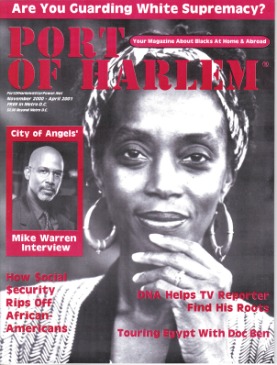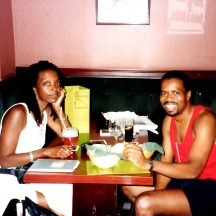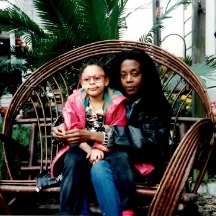
10 Are You a Secondary Guardian to Whites Skin Privilege?
In the article, Elena Featherston continues a discussion she had with Publisher Wayne Young on how Blacks can be conscious and subconscious guardians of white supremacy, ironically, in an Irish Pub in Berlin, Germany, on a hot day.
13 On the Color Black
13 Culture, Not Color
14 True of False? The Truth on Madame C.J. Walker
FEATURE
16 The Blood Cries Out
19 Making the Write Connection
20 Puzzle - Sports and Recreation
20 Liberia, Liberia, It is Mine!
22 Found in Action
DEPARTMENTS
THE PUBLISHER’S POINT
2 Inclusion and Tolerance Starts at Home
A STORY FROM THE OTHER SIDE
3 The "Norman Bates Syndrome"
MONEY MATTERS
4 Egypt is in Africa!
TRAVEL STORY
6 Birmingham-Gary: The Steel Sisters
RECIPE
7 George Washington Carver's Sweet Potato Muffins
PARENTING
7 The Holiday Advantage
MONEY TALKS
8 How to Keep More of Your Hard-Earned Cash
9 How $ocial $ecurity Rips Off African-Americans
INTERVIEW
15 City of Angels' Michael Warren
POETRY PIER
27 Lift E'very Voice and Sing
28 MAKING WAVES
28 COMING UP

It is important to say: I am not neutral. The dynamics of white supremacy, which are addressed here, have affected my life. So, let me put my cards on the table: I am a “dark-skinned” woman with “light-skinned” children and grandchildren. The experiences of those I love have been radically different from my own and have informed and expanded my thinking.
I come to this subject with a perspective and an agenda. My conscious agenda is the long-term well-being of my people (indeed all people) and our healing from the ravages of slavery which still haunt our lives.
My reflections have also been molded by the scholarship on the role that race/color plays in U.S. society. Being human, my reasoning may be flawed and readers my find ways in which my experience has restricted my vision rather than augment it. I look forward to our shared wisdom. This said, I ask: Are you a secondary guardian of white skin privilege?
When the men history remembers as the Buffalo Soldiers were removed from protecting newly freed men and women in the South and transferred west to quell Native people for a racist, expansionist government, these brave men became sentinels for white supremacy.
In western-influenced cultures—globalization makes that most cultures in the world—skin color is the great significator. It is the first thing people see and is used to define who one is and to what one can “rightfully” aspire. There are privileges and a lack thereof attached to different shades of skin, texture of hair, size of lip, and shape of nose neatly encoded into the social fabric of the nation.
Sadly, it is also woven into the social fabric of Black communities. More than Black folk care to admit, our socialization—through centuries of conditioning by European ideals and values—has taught us to live out myths devised to dehumanize us. The internalization of those standards renders us secondary guardians at the gates of white supremacy.
Our watchfulness at the gates of white is time-honored. Even our celebrated dead have stood lookout. When the men history remembers as the Buffalo Soldiers were removed from protecting newly freed men and women in the South and transferred west to quell Native people for a racist, expansionist government, these brave men became sentinels for white supremacy.
Like many people of color, they committed murder to protect property and uphold precepts that White men held dear because they (like us) were trained—miseducated—to revere whatever White men thought important. In struggling to prove their human worth, they defined “duty” as their former masters defined it, not as their Red brothers and sisters who gave them their illustrious name defined it.
The Native people they fought were often our relatives and relations, cut down to further the land-greedy aims of white supremacists. We, modern Blacks, must remember that in the South many African people were also of Native descent. Indigenous people welcomed escaped slaves—so called renegades—into their ethnic groups and families. Every time we enforce the domination of white supremacy in the lives of other peoples of color, we are guardians.

When I ask people of color in my audiences if they consider themselves secondary guardians of white supremacy, usually there is a group reflex action reminiscent of the “wave.” Disavowing heads waggle in the negative, “nuh-uhs” echo throughout the room; negation washes over me at the lectern.
Undaunted I ask what they think a secondary guardian of white supremacy is. Answers offered over the years have included: “people who date White people,” “Uncle Toms,” “people who want to be White,” “people who act White,” “people who don’t know their history,” “Clarence Thomas,” “people who pass for White,” “sellouts,” “folks who’ve forgotten where they come from,” and “people who talk White.”
“What about people who disrespect other people of their own race for being lighter or darker than they find acceptable?” I query. The room grows suddenly hushed, save for scattered fidgeting and nervous coughing. Teeth-sucking and eye-rolling begins; angry people stare at me, in belligerent silence as though daring me to say another word (especially if the audience is racially integrated).
I accept the challenge because we don’t grow as a people if we are always concerned about what White people may or may not think. In that silence many meaningful conversations about the political significance of white supremacy and its relationship to colorism have begun. Naming is critical to healing.
Let’s face it, unlike immigrants from Europe, persons of color will never be accepted into the “circle of whiteness,” but we can be accepted into the outer perimeter of “lightness” and “rightness.”
Each time we disrespect one another because of skin color we are secondary guardians of white supremacy. There are Black people in cities through-out the country, who would not consider me as suitable marriage material because I am “too dark.” They are careful about the partners they choose to ensure the light-skin privilege they experience will benefit their children. The majority of these same individuals would also resist the notion of “improving the race” by “race-mixing,” but cling tenaciously to the skin color that indicates that such “improvement” took place in the past.
These secondary guardians have taken the “brown bag” out of the nightclub into the fabric of their daily lives. There are Black people who consider my friend Mary to be Black even though she is much lighter than my daughter. These same folk insist on calling my daughter “mixed” because her father is “White” (Italian, Irish, and Puerto Rican actually).
Mary is about one-quarter Black, I guess, because both her parents are both about one-eight Black. My daughter on the other hand is one-half Black because I am Black (African, Asian, Irish, and Native (Cherokee/Choctaw) actually.) Why is my daughter “mixed” and Mary is not? In as much as both are Black and clearly ethnically “mixed.”
This discussion reminds me of a conversation eight years earlier in which my friend Virginia said what was missing in the impassioned rhetoric about white supremacy was the fact that Black people “often believe in, have internalized, and perpetuate our inferiority.” We, both darker women, had a candid and rather heated discussion about “colorism” and its prevalence in our community.
Though lighter, Virginia’s treatment at the hands of friends and relatives was vicious and her wounds were deep. For the most part, my family was not given to disrespecting people because of skin color. My family valued its dark members as much as—and sometimes more than--its lighter members. My mother and her siblings span the range from dusky rose to berry black, and she falls somewhere in the middle. My father was very dark, and my brother and I a “nice sweet chocolate.” Virginia and I clashed, but agreed on several things:
- Geographical place and time can influence one’s experience of white supremacy (Virginia is southern born and 10 years my senior. I was born in California.)
- Colorism taints every ethnic group in this country.
- Colorism cuts in both directions light to dark and back again.
Many of us accept the argument that people of color have more in common with the Europeans who colonized, captured, conquered, and commodified us than with one another.
Even Euro-Americans ascribe greater value to blond and blue-eyed northern Europeans than darker southern Europeans. And most importantly, we believe that without the lessons learned as enslaved and or oppressed people, we would not carry the “soul wound” of colorism from generation to generation. However unwillingly, we have internalized the thinking of a culture that rewards those who distance themselves from their ancestral roots, original languages, native foods, family names, spiritual traditions, ancient epistemologies, and personal truths in order to become “American.”
We have, “despite much passionate rhetoric” to the contrary, adapted, but not well. Many of us accept the argument that people of color have more in common with the Europeans who colonized, captured, conquered, and commodified us than with one another. Why? Because of our place of origin, our first language or the color of our skin?
Let’s face it, unlike immigrants from Europe, persons of color will never be accepted into the “circle of whiteness,” but we can be accepted into the outer perimeter of “lightness” and “rightness.” (Not to mention incredible uptightness) Ways of being must be eradicated, patterns and speech modified, associations adjusted. Our basic humanity can be recognized, bur under the right circumstances.
The bitter irony is that by engaging in colorism we conspire with our oppressors in our own oppression, teaching it to our children and enforcing it in our personal, political, and economic interactions. Internalizing the belief that dark is inherently less desirable than light permits the racist tactic of divide – and - rule to operate effectively.
Being in our black skin—light or dark—is a struggle for spiritual integrity we can honor by endeavoring to change maladaptive survival behaviors that no longer serve us. Healing our soul wounds means acknowledging and actively questioning the many ways we safeguard white supremacy. To set ourselves free we must remember who we are and not worry about whom or what we are not.
Re/membering our African center is a form of resistance, it is life-affirming and self-defining.
Re/membering our African center is a refusal to be complicit in our own oppression.
Re/membering our African center is to love our Blackness from light, bright, and damn near white to velvet black.
No more “too dark,” “too light,” “high yellar,” “good hair,” “tar baby,” “bad hair,” “big lips,” “wide nose,” No more self-hatred, which better than guns, maintains white power and the subjugation of our people. Renouncing colorism and all its extant evils defies those who would steal our past, predetermine our future, and cut short our present.
And to do this we must struggle with the covert, subconscious ideas we have been carefully spoon fed. Our survival as a people means breaking the shackles that chain us to the gates of white supremacy as its defenders.
Some of Featherston's Favorite Quotes
“ . . . Colorism – in my definition, prejudicial or preferential treatment of same-race people based solely on their color… colorism, like colonialism, sexism, and racism, impedes us.
-Alice Walker, "If the Present Looks like the Past, What Does the Future Look Like?"
‘’If you’re White you’re all right, if you’re Brown stick around, if you’re Black stand waaaay back.”
–A doggerel remembered from childhood
The One Drop Legacy

Many remember the U.S Supreme Court’s Plessy versus Ferguson ruling in 1896 for making racial segregation legal in the United States after the freeing of the enslaved. However, Plessy’s lawyer didn’t argue that it was illegal for the government to sanction racial segregation.
According to the National Civil Rights Museum in Memphis, he argued against the “right of the State to label one citizen as White and another as Colored.” Plesssy was only one-eighth Black. However, under Louisiana law, the 30-year-old shoemaker was Black.
The particular battle started in 1890 when Louisiana passed the equal, but separate railroad car law. In 1891, a committee decided to test the law’s constitutionality. On June 7, 1892, the committee had Plessy sit in a “White” railroad car. Police arrested him.
It was not until the 1954 Brown versus Board of Education decision that the Supreme Court made American apartheid illegal. It wasn’t until the 1990 Census that the government allowed individuals to declare their own race on census forms. Starting with the 2000 Census, Americans are now able to self-declare more than one race on government forms.




